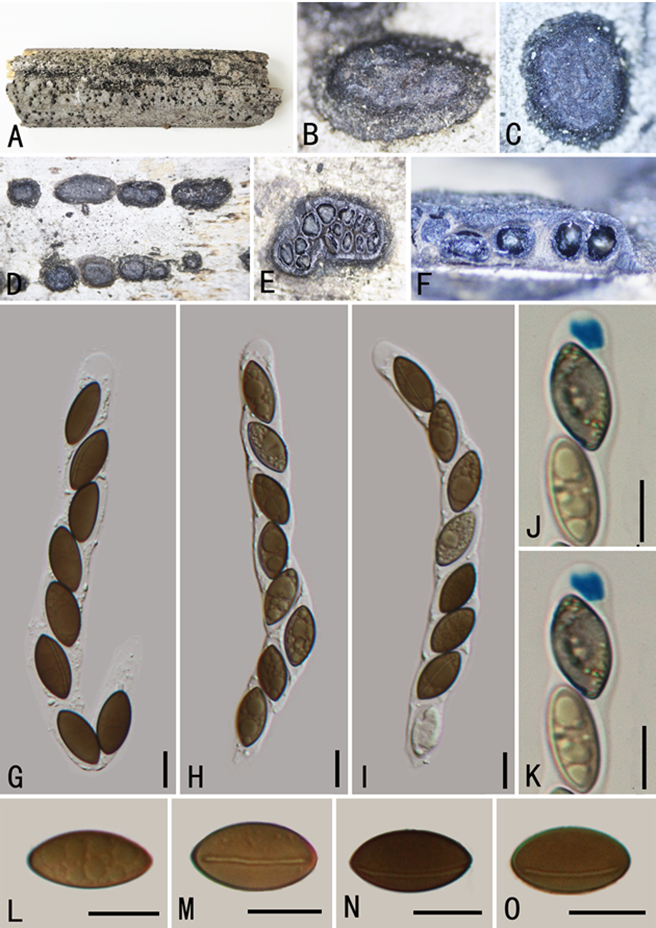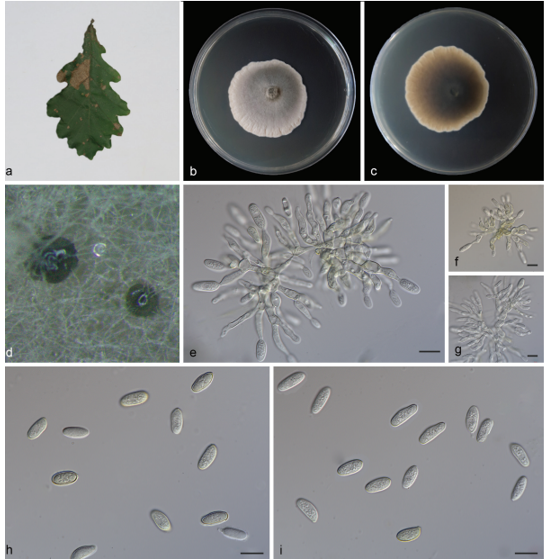Astrocystis multiloculata Y.P. Wu & Q.R. Li, sp. nov. 2021
MycoBank: MB839643
Type: CHINA. Yunnan Province: Baoshan City, Lancang River Nature Reserve (24.51946°N, 99.415778°E), elev. 1747 m, on dead bamboo culms, 10 October 2019, Yinhui Pi2019LC129 (GMB0033, holotype; KUN-HKAS 112661, isotype; ex-type living culture, GMBC0033).
Morphological description
Sexual morph: Stromata erumpent, effused lump with flat top, irregular in outline, with a discoid black base, containing many perithecia (mostly more than 8, with independent ostiole), gregarious or solitary, scattered, carbonaceous, embedded on the host surface, 0.6–3.0 mm diam., 0.6–2.4 mm high, smooth, tissue between perithecia woody. Perithecia spherical to obovate, without carbonaceous stromatal tissue surrounding the individual perithecia. Ostioles at the same level as stromatal surface, with slight papillate openings. Asci 120–142 × 7–12.5 μm (mean 131 × 9.5 μm, n = 30), 8-spored, unitunicate, cylindrical, short-pedicellate, persistent, apically rounded, with J+, square-shaped apical apparatus, blue staining in Melzer’s reagent, 3–5 μm (mean 3.5 μm, n = 30) high, 3.0–4.5 μm (mean 3.3 μm, n = 30) wide. Ascospores 19–25 × 7–11 μm (mean 21.5 × 8.7 μm, n = 30), uniseriate, dark reddish brown, aseptate, equilateral ellipsoid, with rounded ends, smooth, with a straight germ slit slightly less than full-length, lacking appendages and sheath.
Asexual morph: Undetermined
Culture characteristics: Ascospores germinated on PDA within 24 hours, 25 °C, colonies, dense but thinning towards the edge, edge irregular, white from above, reverse similar in colour. No conidia were observed on PDA or OA media.
Habitat: Known to inhabit dead bamboo.
Distribution: Yunnan Province, China.
GenBank Accession:
ITS MW732438; RPB2 MW755331; β-tubulin MW755337; α-actin MW755346
ITS MW732439; RPB2 MW755330; β-tubulin MW755336; α-actin MW755347
Notes: Morphologically, A. multiloculata can be distinguished from other Astrocystis species by its superficial stromata, which contain many perithecia (mostly more than 8, with independent ostiole), and larger ascospores (19–25 × 7–11 μm). Phylogenetic analyses based on ITS, RPB2, β-tubulin and α-actin dataset show that A. multiloculata formed a well-separated clade to A. cocoes with high bootstrap support (Fig. 1). Astrocystis multiloculata shows a close relationship with Kretzschmariella in terms of stromata. Both have stromata containing many perithecia, and ascospores with straight germ slit slightly less than spore-length, but K. culmorum (Cooke) Y.M. Ju & J.D. Rogers (Ju & Rogers 1994) and K. guaduae Viégas (Viégas 1994) usually bear a cellular appendage on immature ascospores which distinguish them from A. multiloculata. Moreover, the phylogenetic tree shows that it is more reasonable to place A. multiloculata in Astrocystis.
Reference: Wu, Y. P., Pi, Y. H., Long, S. H., Lin, Y., Long, Q. D., Kang, J. C., ... & Li, Q. R. (2021). Morphological and phylogenetic study of five species of Astrocystis and Collodiscula on bamboo. Phytotaxa, 522(4), 265-284.

Astrocystis multiloculata (GMB0033, holotype). A. Material. B–D. Stromata on the surface of host. E. Transverse section of stroma. F. Longitudinal section of stroma. G–I. Asci with ascospores. J, K. Ascus apex with a J+, apical apparatus (stained in Melzer’s reagent). L–O. Ascospores. Scale bars: B–F = 200 μm, G–O = 10 μm.









